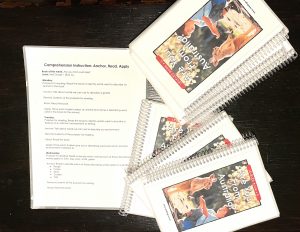What is Anchor, Read, Apply?
If you have read Karen Erickson and David Koppenhaver's text Comprehensive Literacy for All: Teaching Students with Significant Disabilities to Read and Write (2019) then you will be familiar with the Anchor, Read, Apply model of comprehension instruction. And I strongly encourage you to read that chapter for information about how this model reflects the research base in this area.
If you haven’t read the text – (and please do) –here’s a brief rundown of the parts of Anchor Read Apply.
Anchor
This consists of two parts. Beginning readers haven’t learned to set their own purposes for reading – so we give them a purpose as part of the anchor. And then we make sure that we activate any background knowledge they need for extracting that information from the text.
Read
This is where the student reads the book.
Apply
This is where we take the information needed for the purpose and use it – which could be in a discussion, in writing or in another task.
Selecting the text
It is important that we select a text to use for comprehension instruction that is at or below our student’s reading comprehension level.
When a student is just starting to move to conventional instruction, this means that we need a very simple text – and it would be great to use a text that will interest them. As you know, this isn’t an easy task. Reading A-Z is one of the options that I use in this space. It provides levelled texts, many of which are non-fiction and photo based and what I call “age neutral” – which means they are often suitable for teens who are beginning readers as well. Other options I use are to find a book on Tar Heel Reader and check the level in the Readability Checker in Microsoft Word or to write my own text, again using the Readability Checker to make sure I get the level correct. I can also find books in other levelled readers scheme, particularly some of the non-fiction curriculum based texts.
As students read at more advanced levels, then the range of books widens and we have a lot more options available. We just always need to make sure that the text is at or below our student's reading comprehension level.
Planning
Once I have selected the text then I move onto the planning.
Planning the Anchors
The first part of planning is the anchor, beginning with the purpose for reading. In Australia we are very lucky because our Australian Curriculum has guidelines around what a student should be able to do with a text at different grade levels. At Foundation (our first year of school) these start with “whole of text” understandings, such as generating an alternative title, talking about a character’s feelings or describing the setting. If you have read the chapter from Karen and Dave’s book you’ll know that it is important to start with these purposes rather than reading to focus on small details. These overall purposes are what is recommended in beginning comprehension instruction – and are important for developing an understanding of what the whole of the book means.
When I am explaining this in workshops I often talk about the Very Hungry Caterpillar as an example. I know a lot of students who can tell you the food the caterpillar eats on each day but who don’t understand that it is a text about a life cycle. If you don’t understand what the overall story of the Very Hungry Caterpillar means then you have missed the point of the text.
For Australian readers, here is a document I compiled of purposes for reading linked to our curriculum.
Planning the “Apply”
Since I might have someone else implementing the comprehension instruction I have planned, I also spell out the apply part. I write down whether students will be discussing the purpose or writing about it - or doing something else. See my examples of planning below to see this. Each of these examples uses a book from Reading A-Z which you can download from their website. If you don't already have a subscription to Reading A-Z you can sign up for a 14 day trial or a subscription online.
Examples of Planning using Australian Curriculum
Foundation Level (also called Kindergarten, Reception and Prep)
Year 1
Year 2
Getting Organised
And once the planning is complete, then I make sure I have everything else I need. It is particularly important that there is one copy of the text for each student since they will be reading it. And, of course, the planning needs to be available!

Implementation
The implementation piece is where we continue to need to differentiate depending on the student’s reading level.
Foundation (also called Kindergarten, Reception and Prep)
For students whose reading level is equivalent to Foundation in Australia we aim to do gradual release of responsibility across the week.
This happens during the “read” part of Anchor Read Apply and looks like this:
- Monday – everyone has a copy of the book, teacher reads and students follow along (and read if they want to)
- Tuesday – teacher reads and students follow along
- Wednesday – Everyone reads. Students can read with their inner voice or out loud
- Thursday – students read. Teacher is there for support as needed.
- Friday – students read. Support if needed.
Year 1
Once a student is at Year 1, we still support with gradual release of responsibility but it is shorter.
- Monday – everyone has a copy of the book, teacher reads and students follow along (and read if they want to)
- Tuesday to Friday – students read. Teacher is there for support as needed
Year 2 and above
For students in Second Grade we would expect them to read the text independently from the beginning of the week.
And if you want more information, here is a handout I’ve prepared explaining in more detail how to do Gradual Release of responsibility across the week using a book from Tar Heel Reader as the example text.
Reading Comprehension is the goal
And don't forget - silent reading with comprehension is the goal of all comprehension instruction. And for every student to read with comprehension at one grade level higher, they need to be learning to juggle reading and comprehending together. I hope these resources help you and I'd love to hear any feedback or ideas you have!


bunnycharlotte
jane